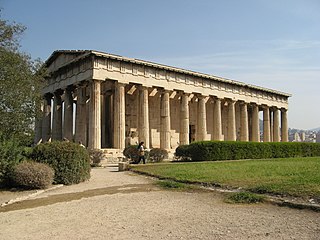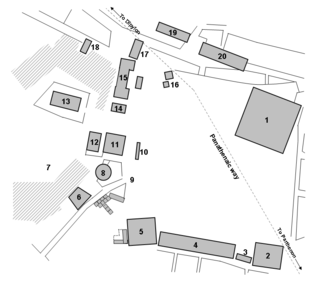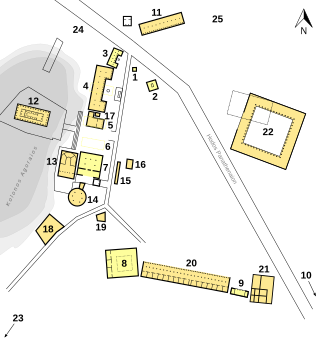
Pergamon or Pergamum, also referred to by its modern Greek form Pergamos (Πέργαμος), was a rich and powerful ancient Greek city in Mysia. It is located 26 kilometres (16 mi) from the modern coastline of the Aegean Sea on a promontory on the north side of the river Caicus and northwest of the modern city of Bergama, Turkey.

Eleusinion, also called the City Eleusinion was a sanctuary on the lower part of the north slope of the Acropolis in Athens, Greece, dedicated to Demeter and Kore (Persephone). It was the central hub of Eleusinian Mysteries within Athens and the starting point for the annual procession to Eleusis, in the northwest of Attica. Religious activity is attested in the area from the 7th century BC and construction took place throughout late Archaic, Classical, Hellenistic, and Roman periods. The sanctuary was enclosed within the new city walls built after the Herulian sack of Athens in AD 267 and it remained in use until the late fourth century AD.

The Temple of Hephaestus or Hephaisteion, is a well-preserved Greek temple dedicated to Hephaestus; it remains standing largely intact today. It is a Doric peripteral temple, and is located at the north-west side of the Agora of Athens, on top of the Agoraios Kolonos hill. From the 7th century until 1834, it served as the Greek Orthodox church of Saint George Akamates. The building's condition has been maintained due to its history of varied use.

The ancient Agora of Athens is the best-known example of an ancient Greek agora, located to the northwest of the Acropolis and bounded on the south by the hill of the Areopagus and on the west by the hill known as the Agoraios Kolonos, also called Market Hill. The Agora's initial use was for a commercial, assembly, or residential gathering place.

The Stoa of Attalos was a stoa in the Agora of Athens, Greece. It was built by and named after King Attalos II of Pergamon, who ruled between 159 BC and 138 BC. The building was reconstructed from 1952 to 1956 by the American School of Classical Studies at Athens and currently houses the Museum of the Ancient Agora.

Stoa Basileios, meaning Royal Stoa, was a Doric stoa in the northwestern corner of the Athenian Agora, which was built in the 6th century BC, substantially altered in the 5th century BC, and then carefully preserved until the mid-second century AD. It is among the smallest known Greek stoas, but had great symbolic significance as the seat of the Athenian King Archon, repository of Athens' laws, and site of "the stone" on which incoming magistrates swore their oath of office.

The South Stoa I of Athens was a two-aisled stoa located on the south side of the Agora, in Athens, Greece, between the Aiakeion and the Southeast Fountain House. It probably served as the headquarters and dining rooms for various boards of Athenian officials. It was built at the end of the 5th century BC and remained in use until the mid-second century BC, when it was replaced by South Stoa II.

The Odeon of Agrippa was a large odeon located in the centre of the ancient Agora of Athens. It was built about 15 BC, occupying what had previously been open space in the centre of the Agora. It was a gift to the people of Athens by Marcus Vipsanius Agrippa, a Roman statesman and general.

The Sanctuary of Aphrodite Urania was located north-west of the Ancient Agora of Athens and dedicated to the goddess Aphrodite under her epithet Urania. It has been identified with a sanctuary found in this area in the 1980s. This sanctuary initially consisted of a marble altar that was built around 500 BC and was gradually buried as the ground level rose. Another structure, perhaps a fountainhouse, was built to the west ca. 100 BC. In the early 1st century AD, an Ionic tetrastyle prostyle temple closely modelled on the Erechtheion's north porch, that was built to the north of the altar.

The Temple of Apollo Patroos is a small ruined temple on the west side of the Ancient Agora of Athens. The original temple was an apsidal structure, built in the mid-sixth century BC and destroyed in 480/79 BC. The area probably remained sacred to Apollo. A new hexastyle ionic temple was built ca. 306-300 BC, which has an unusual L-shaped floor plan. Some fragments from the sculptural decoration of this structure survive. The colossal cult statue, by Euphranor, has also been recovered.

The Church of the Holy Apostles, also known as Holy Apostles of Solaki, is located in the Ancient Agora of Athens, Greece, next to the Stoa of Attalos, and can be dated to around the late 10th century.

Mary Alison Frantz was an American archaeological photographer and a Byzantine scholar. She is best known for her work as the official photographer of the excavations of the Agora of Athens, and for her photographs of ancient Greek sculpture, including the Parthenon frieze and works from the Temple of Zeus at Olympia.

The Roman Agora at Athens is located to the north of the Acropolis and to the east of the Ancient Agora.
Stephen Victor Tracy is an American scholar of Classics specializing in ancient Greek Epigraphy. Inscriptions are one of the most important classes of primary evidence that comes down to us from antiquity. Tracy is best known for devising a method for recognizing the work of individual inscribers. It was long thought that the intractability of the medium made this impossible. But by treating the inscribed letters as a kind of handwriting he has been able to establish careers for many cutters, to join discrete fragments, to date inscriptions more accurately than in the past, and often thereby make it possible to reach a new understanding of historical events.
The New Bouleuterion is an ancient building in the city of Athens in Attica, Greece. It was located on the western side of the Ancient Athenian Agora. It is a theater with 12 rows of seats, with a seating capacity of greater than 500. A bouleuterion, sometimes translated as council house, assembly house, and senate house, was a building in ancient Greece which housed the council of citizens of a democratic city-state.

The Square Peristyle is the modern name for a structure on the east side of the Ancient Agora of Athens, which was among the largest peristyles built in Classical Grece. Construction began around 300 BC, but was abandoned ca. 285-275 BC, leaving the structure unfinished. It probably served as Athens' law courts at the beginning of the Hellenistic period, but fell out of use. In the early second century BC the building was demolished and the material was reused in South Stoa II, on the southern side of the Agora. The Stoa of Attalos was subsequently built over the top of its foundations.

South Stoa II was a stoa on the south side of the Agora in ancient Athens. It formed the south side of an enclosed complex called the South Square, which was built in the mid-second century BC and may have been intended for use as lawcourts.

The East Building was a rectangular structure at the south end of the Agora in ancient Athens. It was built in the mid-second century BC as the east side and main entrance to an enclosed complex called the South Square, which may have served as a commercial area or as lawcourts. The structure was damaged in the Sullan Sack of 86 BC and used for industrial purposes until the early second century AD when it was rebuilt. It was demolished after the Herulian Sack of 267 AD and used as building material for the Post-Herulian Wall.














